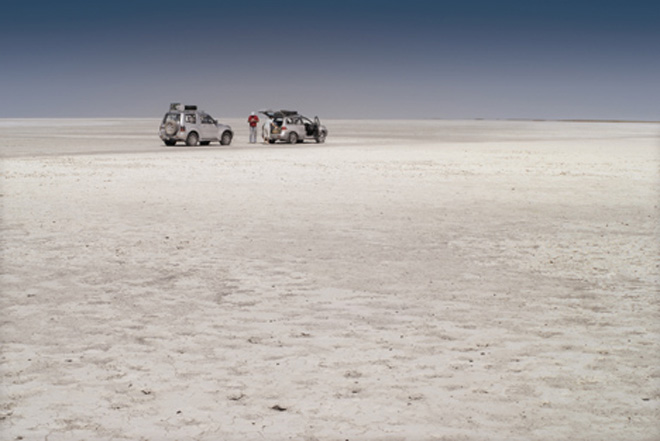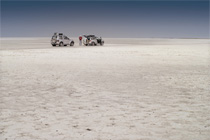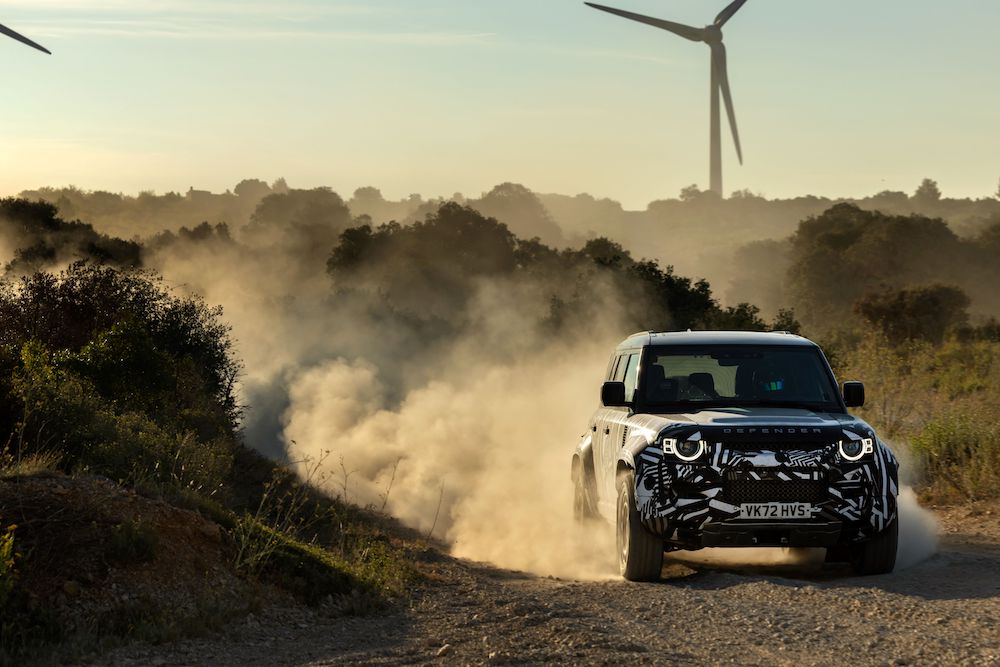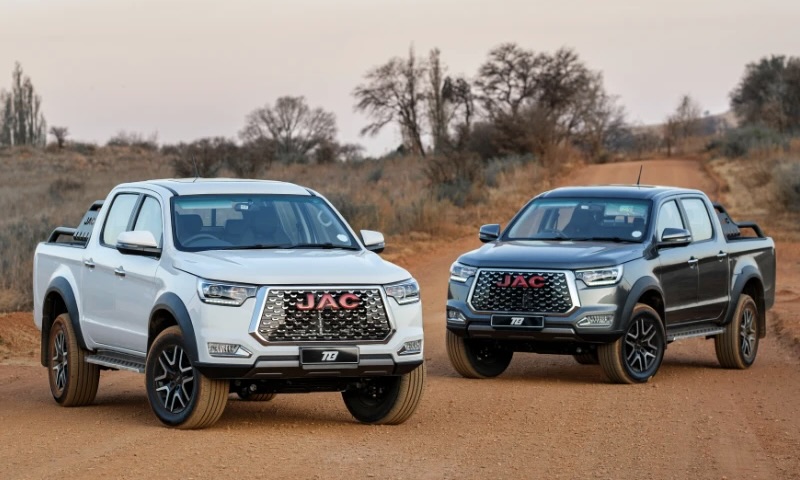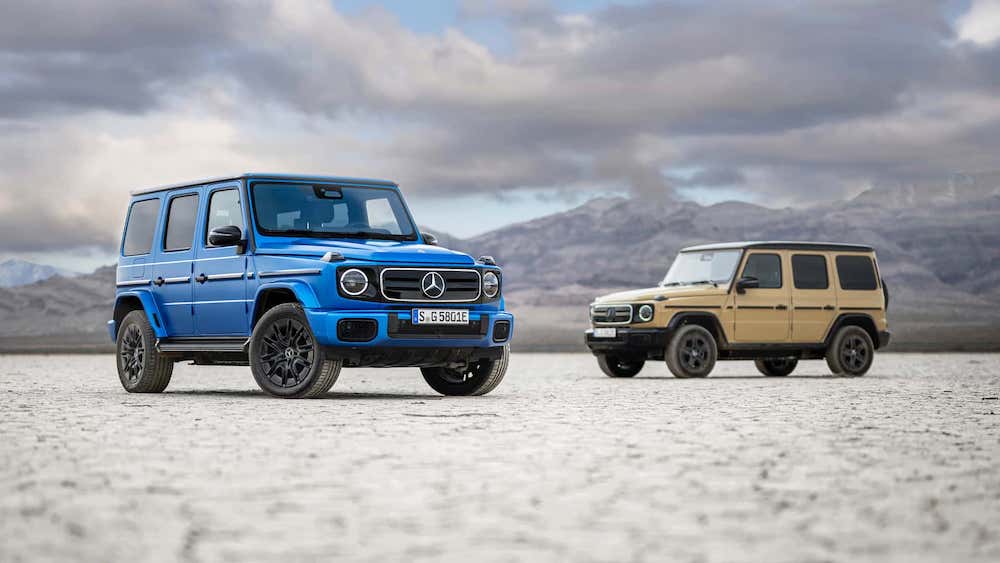Text and photographs: Andy Stead
How did it all start? What was the motivation? Would it work? Our English based friends decided on a tour of Namibia in a rented 4×4 out of Windhoek. My nephew in Cape Town who had toured Namibia in his SWB Pajero last year was also keen. The plot was hatched, but questions remained: Would the three-year-old Hyundai Santa Fe of mine be up to the job? Would it stay with the rented Nissan and the Pajero? Or would it prove a liability and hold everyone up?
On a road trip a year or so ago we went up Sani Pass, then across to Maseru via Khatse. The Santa Fe did well, and with the exception of a blow out, we were hardly taxed. So Namibia? Why not?
The plan for the trip was to spend the first night in Nata, then on to Kasane, a tour of Chobe, then through Savuti to Maun. From Maun to the Caprivi, then into Namibia and some time in Etosha, where we would meet up with our English friends. There we would split up again, with the Pajero and Santa Fe off to Terrace Bay, and the English friends on their way up to Koakoland.
We would then go from Terrace Bay down through Swakopmund and Walvis Bay to Sossusvlei, and a possible trip through the Transfrontier Park back to Johannesburg. A total of 17 days, with camping as the main accommodation, although some lodges and B&Bs where camping was not practical.
A temporary roof carrier was fitted to the Santa Fe for an additional spare wheel, fuel, water tanks and sand tracks. Other than that the vehicle was bog standard. Whilst the 4X4 capabilities had been tested on the Lesotho trip, and found to be good even with no low-range, the clearance was cause for concern, particularly the diff area which is protected by a rather flimsy metal guard.
In spite of my nephew’s continued concern over the vehicle’s capabilities, we were cautiously optimistic, and early morning on a perfect highveld spring day saw us off for Nata, together with the Pajero.
Arriving at Nata Lodge (after a 1 000 pula speeding fine!) we found that although we had an email confirmation that we could camp there, we were told we could not as they were still repairing their fire damage (never believe what you are told in emails!). We went on to Nata town, and bedded down in a roadside motel. Next day we headed for Gweta which was a really good base to explore the Makgadikgadi Pans. So off we went to explore, with the Pajero leading, and on a road that looked as if it was going nowhere. And we did exactly that.
Two hours later we were lost, and after driving over a tree stump I had the first of several blowouts. Directions from a kraal took us close to the pans, and through some pretty rough sections where we began to hear what would become a well known sound – the scraping of the underside on the middelmannetjie. To avoid this one tends to favour one side of the track, and whilst this works, it slows you down, and you become vulnerable to objects on the roadside.
The pan is incredible, and the short time we had there did not do it justice. There were apparently zebras in huge herds in the area, but we never saw them. Back to Nata the following morning, and with warnings of the bad road conditions from Nata to Kasane, we set off early.
For those who have used the Nata/Kasane road you will know what was to come. This road is now used by heavy traffic from Zambia instead of the route through Zimbabwe, so it’s BUSY. There is little tar left, just a mess of massive holes and detours. The lorries, however, still push along at insane speeds, and we ended up driving right off the road on tracks made by other vehicles. Slow progress, but safer than being on the “road”. Kasane was reached and there we found a new tyre – but slightly different to the ones on the vehicle, with road tread, and at a huge price, but still better than nothing.
Chobe is great. We stayed at Toro Lodge, in cabins next to the river. We went fishing, caught barbel, ate well, and saw great sightings of game including a lion kill of an elephant, would you believe.
Next stop was Audi Camp in Maun. Again we had been told that the Kasane to Maun road was bad, but the park’s man at the gate was more encouraging, claiming it was OK. A driver of a Unimog who had just done the road begged to differ, and said it was bloody awful. We chose to favour the park’s guy being the eternal optimists that we are.
The road was from hell. We led the way with the Pajero following. It started off OK, but soon became nothing but soft sand, with a huge middelmannetjie. This made trying to drive with one wheel on the verge and the other in the middle impossible. The only way to progress was to drive fast, skidding along on the bottom of the Santa Fe, praying that there were no rocks or obstructions in the middle, and also that there wouldn’t be much traffic coming the opposite way.
The first test was a huge lorry stationary in the middle of the track. We pulled out to avoid it just in time, and wrestled the Santa Fe out of the ruts, only to slide back when opposite the lorry, and collide with the side, fortunately at low speed. Horrified, and with anticipation of much damage, we discovered that the side mirror was the only real casualty.
Not much further on and we came to a halt with the bottom of the car resting on the middelmannetjie. With the Pajero preparing to pull us out, and several vehicles coming in the opposite direction waiting for us, we managed to reverse with a push, and found firmer ground off the main road, almost in the bush.
This is where we stayed for the balance of the soft sand, and whilst we made slow progress, we didn’t get stuck again.
After Savuti, and close to the main Maun road, we again seemed to have veered off course a bit, and the track we followed crossed a river with a few logs thrown across. This also posed clearance problems for the Santa Fe, so we had to prepare the approach to allow for this – then across no problem.
Audi Camp was great, and a good springboard for the swamps. After a game drive, mokoro trip, and an indulgent flip over the swamps in a Cessna 206, we headed for the Namibian border at Muhembo, and a wonderful night at Mukwe. There we camped right on the banks of the Okavango river.
Then it was on to Etosha and our reunion with English friends. We stayed at Namutoni the first night and Halali for two further nights. Good game sightings, but not to the extent of Chobe, and the park was very busy. Dozens of international tourists, mostly in self drive 4X4s.
We bade farewell to the English explorers here, as they travelled north, and we went down to Terrace Bay. An extremely rocky road, but incredible scenery, particularly along the Skeleton Coast where we had our second blowout. Terrace Bay is extremely desolate, but an oasis with good accommodation and great food.
We retraced our steps along the coast and then the salt road to Swakopmund, where we found a new tyre at more than double the South African price. We enjoyed Swakopmund and its German influence, and enjoyed the stay at Hotel A la Mer, an extremely affordable and welcoming respite from camping.
Ever onwards to Sossusvlei for an overnight camp and a sunrise exploration of the incredible dunes. Again an amazing number of tourists in the camp site, mainly Italians making an exceptional amount of noise in an otherwise quiet spot. Sossusvlei is truly remarkable, particularly at sunrise, as is “Dead mans Pan” with its stark flat unreality and those beautiful dead trees.
Shortly after leaving Sossusvlei, we had a third blowout close to Tsarishoogte Pass. By this stage we decided it was time to call it a day, and left out Transfrontier in favour of the easy route home via Keetmanshoop and Upington. We were tired of travelling by this stage and felt we had done enough.
So what did we learn from this trip? Firstly, the Santa Fe was not completely out of its depth (if you’ll excuse the pun!), apart from the clearance problem ( 20cm from diff guard to ground). It handled the serious 4×4 sections well, and never stalled in either the soft sand or the incline sections, despite no low range.
Its soft points, if anything, were the tyres, which were standard Khumo 225/70R16. I suspect these have weak sidewalls, as any contact seemed to cause massive damage instead of a possible routine puncture.
Mechanically the Santa Fe was fine – it never missed a beat and required no oil or water. Apart from the wing mirror and scratches there was no body damage at all. After 7200km of this kind of terrain, that’s not a bad endorsement.
So – would we do it again? Certainly. The confidence level in the vehicle has improved, and that is often half the problem. I would do a better job of the roof rack, and would certainly put better all terrain tyres on, possibly increasing the sidewall height on the rear to gain those precious extra centimetres.
So come on all you softies out there – don’t be intimidated by all those “muscle” machines, take your softie and give it a go. Oh, and the Pajero performed as well as a Pajero performs: Magnificently!
